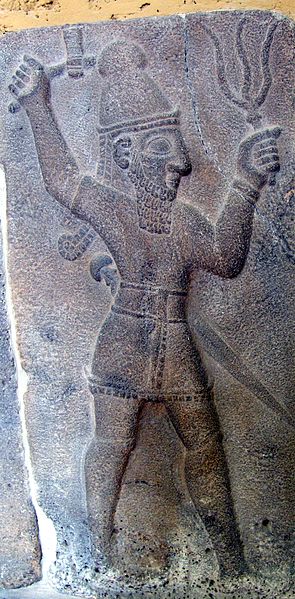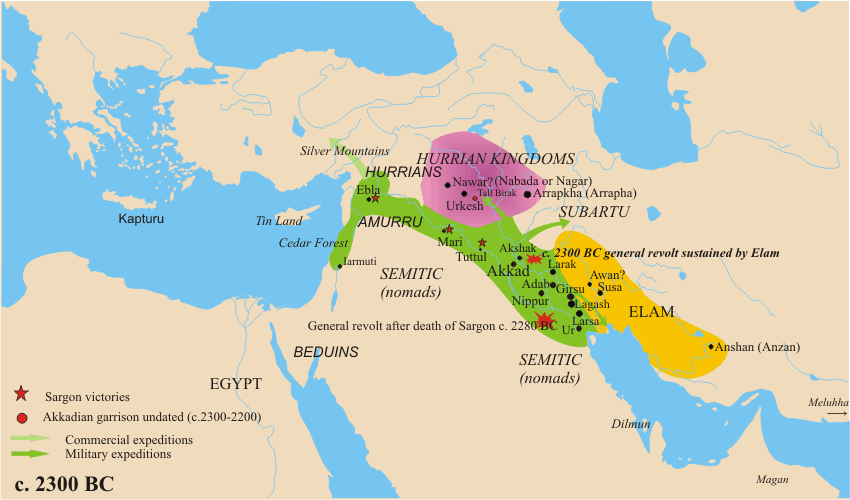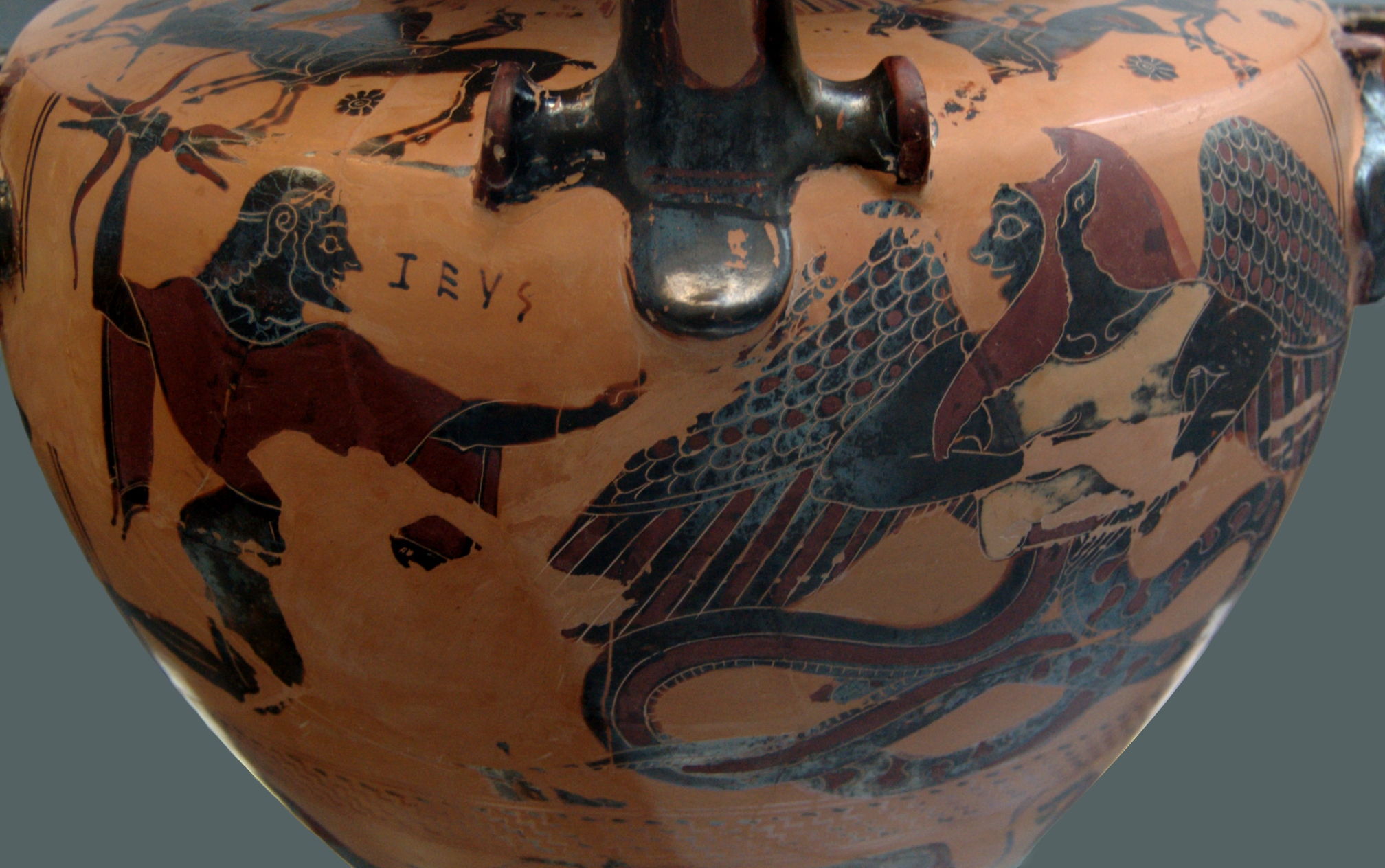|
Song Of Ullikummi
__NOTOC__ In Hurrian mythology, Ullikummi is a giant stone monster, son of Kumarbi and the sea god's daughter, Sertapsuruhi, or a female cliff. The language of the literary myth in its existing redaction is Hittite, in cuneiform texts recovered at Bogaskoy, where some Hurrian fragments of the "Song of Ullikummi" have been found. ''See'' Guterbock (1951). The "song of Ullikummi" was recognized from its first rediscovery as a predecessor of Greek myths in Hesiod Hesiod (; grc-gre, Ἡσίοδος ''Hēsíodos'') was an ancient Greek poet generally thought to have been active between 750 and 650 BC, around the same time as Homer. He is generally regarded by western authors as 'the first written poet i .... Parallels to the Greek myth of Typhon, the ancient antagonist of the thunder-god Zeus, have been elucidated by Burkert. The story of Ullikummi The narrative of Ullikummi is one episode, the best preserved and most complete, in an epic cycle of related "songs" about the ... [...More Info...] [...Related Items...] OR: [Wikipedia] [Google] [Baidu] |
Kumarbi
Kumarbi was an important god of the Hurrians, regarded as "the father of gods." He was also a member of the Hittite pantheon. According to Hurrian myths, he was a son of Alalu, and one of the parents of the storm-god Teshub, the other being Anu (the Mesopotamian sky god). His cult city was Urkesh. Syncretism God lists from Ugarit equate Kumarbi with the Mesopotamian Enlil and the local El; other sources equate him with the Syrian Dagan as well, and he was even called "the Dagan of the Hurrians." It's also been proposed that a Hurro-Akkadian god list from Emar equates Ishtaran with him for uncertain reasons. Due to particularly close syncretism between Dagan and Kumarbi due to their shared role as "fathers of gods" in Syria, Dagan's wife Shalash was also viewed as his spouse, though he has other consorts in myths: an unnamed mortal woman and Sertapsuruhi, daughter of the sea god. Kumarbi cycle Kumarbi is known from a number of mythological texts, sometimes summarized unde ... [...More Info...] [...Related Items...] OR: [Wikipedia] [Google] [Baidu] |
Teshub
Teshub (also written Teshup, Teššup, or Tešup; cuneiform ; hieroglyphic Luwian , read as ''Tarhunzas'';Annick Payne (2014), ''Hieroglyphic Luwian: An Introduction with Original Texts'', 3rd revised edition, Wiesbaden: Harrassowitz Verlag, p. 159. Ugaritic 𐎚𐎘𐎁, ''TṮB'') was the Hurrian god of sky, thunder, and storms. Taru was the name of a similar Hattic storm god, whose mythology and worship as a primary deity continued and evolved through descendant Luwian and Hittite cultures. In these two, Taru was known as ''Tarhun / Tarhunt- / Tarhuwant- / Tarhunta'', names derived from the Anatolian root ''*tarh'' "to defeat, conquer". Taru/Tarhun/Tarhunt was ultimately assimilated into and identified with the Hurrian Teshub around the time of the religious reforms of Muwatalli II, ruler of the Hittite New Kingdom in the early 13th century BCE. [...More Info...] [...Related Items...] OR: [Wikipedia] [Google] [Baidu] |
Hurrian
The Hurrians (; cuneiform: ; transliteration: ''Ḫu-ur-ri''; also called Hari, Khurrites, Hourri, Churri, Hurri or Hurriter) were a people of the Bronze Age Near East. They spoke a Hurrian language and lived in Anatolia, Syria and Northern Mesopotamia. The largest and most influential Hurrian nation was the kingdom of Mitanni, its ruling class perhaps being Indo-Aryan speakers. The population of the Hittite Empire in Anatolia included a large population of Hurrians, and there is significant Hurrian influence in Hittite mythology. By the Early Iron Age, the Hurrians had been assimilated with other peoples. The state of Urartu later covered some of the same area. Language The Hurrian language is closely related to the Urartian language, the language of the ancient kingdom of Urartu. Together they form the Hurro-Urartian language family. The external connections of the Hurro-Urartian languages are disputed. There exist various proposals for a genetic relationship to ot ... [...More Info...] [...Related Items...] OR: [Wikipedia] [Google] [Baidu] |
Mythology
Myth is a folklore genre consisting of narratives that play a fundamental role in a society, such as foundational tales or origin myths. Since "myth" is widely used to imply that a story is not objectively true, the identification of a narrative as a myth can be highly controversial. Many adherents of religions view their own religions' stories as truth and so object to their characterization as myth, the way they see the stories of other religions. As such, some scholars label all religious narratives "myths" for practical reasons, such as to avoid depreciating any one tradition because cultures interpret each other differently relative to one another. Other scholars avoid using the term "myth" altogether and instead use different terms like "sacred history", "holy story", or simply "history" to avoid placing pejorative overtones on any sacred narrative. Myths are often endorsed by secular and religious authorities and are closely linked to religion or spirituality. Many soc ... [...More Info...] [...Related Items...] OR: [Wikipedia] [Google] [Baidu] |
Hittite Language
Hittite (natively / "the language of Neša", or ''nešumnili'' / "the language of the people of Neša"), also known as Nesite (''Nešite'' / Neshite, Nessite), is an extinct Indo-European language that was spoken by the Hittites, a people of Bronze Age Anatolia who created an empire centred on Hattusa, as well as parts of the northern Levant and Upper Mesopotamia. The language, now long extinct, is attested in cuneiform, in records dating from the 17th (Anitta text) to the 13th centuries BCE, with isolated Hittite loanwords and numerous personal names appearing in an Old Assyrian context from as early as the 20th century BCE, making it the earliest-attested use of the Indo-European languages. By the Late Bronze Age, Hittite had started losing ground to its close relative Luwian. It appears that in the 13th century BCE, Luwian was the most widely spoken language in the Hittite capital, Hattusa. After the collapse of the Hittite New Kingdom during the more general Late Bro ... [...More Info...] [...Related Items...] OR: [Wikipedia] [Google] [Baidu] |
Bogaskoy
Hattusa (also Ḫattuša or Hattusas ; Hittite: URU''Ḫa-at-tu-ša'', Turkish: Hattuşaş , Hattic: Hattush) was the capital of the Hittite Empire in the late Bronze Age. Its ruins lie near modern Boğazkale, Turkey, within the great loop of the Kızılırmak River (Hittite: ''Marashantiya''; Greek: '' Halys''). Hattusa was added to the UNESCO World Heritage Site list in 1986. Surroundings The landscape surrounding the city included rich agricultural fields and hill lands for pasture as well as woods. Smaller woods are still found outside the city, but in ancient times, they were far more widespread. This meant the inhabitants had an excellent supply of timber when building their houses and other structures. The fields provided the people with a subsistence crop of wheat, barley and lentils. Flax was also harvested, but their primary source for clothing was sheep wool. They also hunted deer in the forest, but this was probably only a luxury reserved for the nobility. Domest ... [...More Info...] [...Related Items...] OR: [Wikipedia] [Google] [Baidu] |
Greek Myth
A major branch of classical mythology, Greek mythology is the body of myths originally told by the ancient Greeks, and a genre of Ancient Greek folklore. These stories concern the origin and nature of the world, the lives and activities of deities, heroes, and mythological creatures, and the origins and significance of the ancient Greeks' own cult and ritual practices. Modern scholars study the myths to shed light on the religious and political institutions of ancient Greece, and to better understand the nature of myth-making itself. The Greek myths were initially propagated in an oral-poetic tradition most likely by Minoan and Mycenaean singers starting in the 18th century BC; eventually the myths of the heroes of the Trojan War and its aftermath became part of the oral tradition of Homer's epic poems, the ''Iliad'' and the ''Odyssey''. Two poems by Homer's near contemporary Hesiod, the ''Theogony'' and the ''Works and Days'', contain accounts of the genesis of the ... [...More Info...] [...Related Items...] OR: [Wikipedia] [Google] [Baidu] |
Hesiod
Hesiod (; grc-gre, Ἡσίοδος ''Hēsíodos'') was an ancient Greek poet generally thought to have been active between 750 and 650 BC, around the same time as Homer. He is generally regarded by western authors as 'the first written poet in the Western tradition to regard himself as an individual persona with an active role to play in his subject.' Ancient authors credited Hesiod and Homer with establishing Greek religious customs. Modern scholars refer to him as a major source on Greek mythology, farming techniques, early economic thought, archaic Greek astronomy and ancient time-keeping. Life The dating of Hesiod's life is a contested issue in scholarly circles (''see § Dating below''). Epic narrative allowed poets like Homer no opportunity for personal revelations. However, Hesiod's extant work comprises several didactic poems in which he went out of his way to let his audience in on a few details of his life. There are three explicit references in ''Works and Days'' ... [...More Info...] [...Related Items...] OR: [Wikipedia] [Google] [Baidu] |
Typhon
Typhon (; grc, Τυφῶν, Typhôn, ), also Typhoeus (; grc, Τυφωεύς, Typhōeús, label=none), Typhaon ( grc, Τυφάων, Typháōn, label=none) or Typhos ( grc, Τυφώς, Typhṓs, label=none), was a monstrous serpentine giant and one of the deadliest creatures in Greek mythology. According to Hesiod, Typhon was the son of Gaia and Tartarus. However, one source has Typhon as the son of Hera alone, while another makes Typhon the offspring of Cronus. Typhon and his mate Echidna were the progenitors of many famous monsters. Typhon attempted to overthrow Zeus for the supremacy of the cosmos. The two fought a cataclysmic battle, which Zeus finally won with the aid of his thunderbolts. Defeated, Typhon was cast into Tartarus, or buried underneath Mount Etna, or in later accounts, the island of Ischia. Typhon mythology is part of the Greek succession myth, which explained how Zeus came to rule the gods. Typhon's story is also connected with that of Python (the serpent ... [...More Info...] [...Related Items...] OR: [Wikipedia] [Google] [Baidu] |
Zeus
Zeus or , , ; grc, Δῐός, ''Diós'', label=Genitive case, genitive Aeolic Greek, Boeotian Aeolic and Doric Greek#Laconian, Laconian grc-dor, Δεύς, Deús ; grc, Δέος, ''Déos'', label=Genitive case, genitive el, Δίας, ''Días'' () is the sky father, sky and thunder god in ancient Greek religion, who rules as king of the gods on Mount Olympus. His name is cognate with the first element of his ancient Roman religion, Roman interpretatio graeca, equivalent Jupiter (mythology), Jupiter.''Larousse Desk Reference Encyclopedia'', The Book People, Haydock, 1995, p. 215. His mythology and powers are similar, though not identical, to those of Indo-European deities such as Jupiter, Perkūnas, Perun, Indra, Dyaus, and Zojz (deity), Zojz. Entry: "Dyaus" Zeus is the child of Cronus and Rhea (mythology), Rhea, the youngest of his siblings to be born, though sometimes reckoned the eldest as the others required disgorging from Cronus's stomach. In most traditions, he is m ... [...More Info...] [...Related Items...] OR: [Wikipedia] [Google] [Baidu] |
Walter Burkert
Walter Burkert (; 2 February 1931 – 11 March 2015) was a German scholar of Greek mythology and cult. A professor of classics at the University of Zurich, Switzerland, he taught in the UK and the US. He has influenced generations of students of religion since the 1960s, combining in the modern way the findings of archaeology and epigraphy with the work of poets, historians, and philosophers. He was a member of both the American Philosophical Society and the American Academy of Arts and Sciences. He published books on the balance between lore and science among the followers of Pythagoras, and more extensively on ritual and archaic cult survival, on the ritual killing at the heart of religion, on mystery religions, and on the reception in the Hellenic world of Near Eastern and Persian culture, which sets Greek religion in its wider Aegean and Near Eastern context. First academic era Burkert was born in Neuendettelsau. He married Maria Bosch in 1957 and they had three chi ... [...More Info...] [...Related Items...] OR: [Wikipedia] [Google] [Baidu] |
Underworld
The underworld, also known as the netherworld or hell, is the supernatural world of the dead in various religious traditions and myths, located below the world of the living. Chthonic is the technical adjective for things of the underworld. The concept of an underworld is found in almost every civilization and "may be as old as humanity itself". Common features of underworld myths are accounts of living people making journeys to the underworld, often for some heroic purpose. Other myths reinforce traditions that entrance of souls to the underworld requires a proper observation of ceremony, such as the ancient Greek story of the recently dead Patroclus haunting Achilles until his body could be properly buried for this purpose. Persons having social status were dressed and equipped in order to better navigate the underworld. A number of mythologies incorporate the concept of the soul of the deceased making its own journey to the underworld, with the dead needing to be taken a ... [...More Info...] [...Related Items...] OR: [Wikipedia] [Google] [Baidu] |








